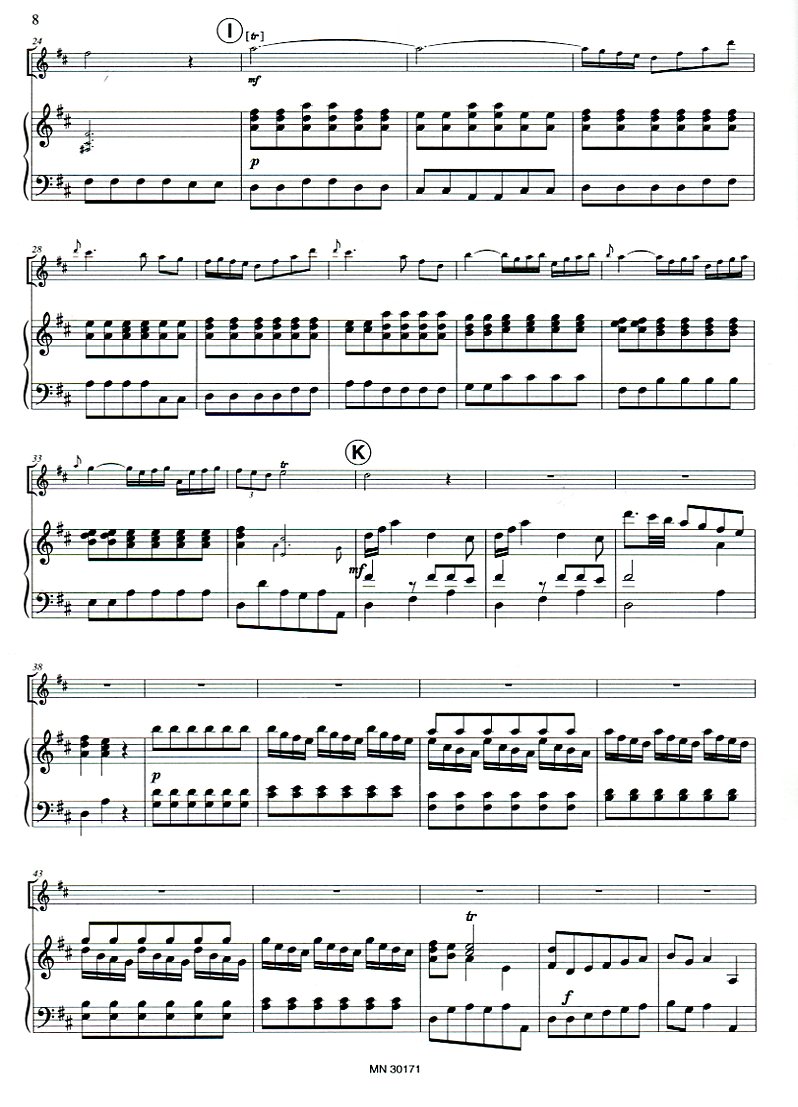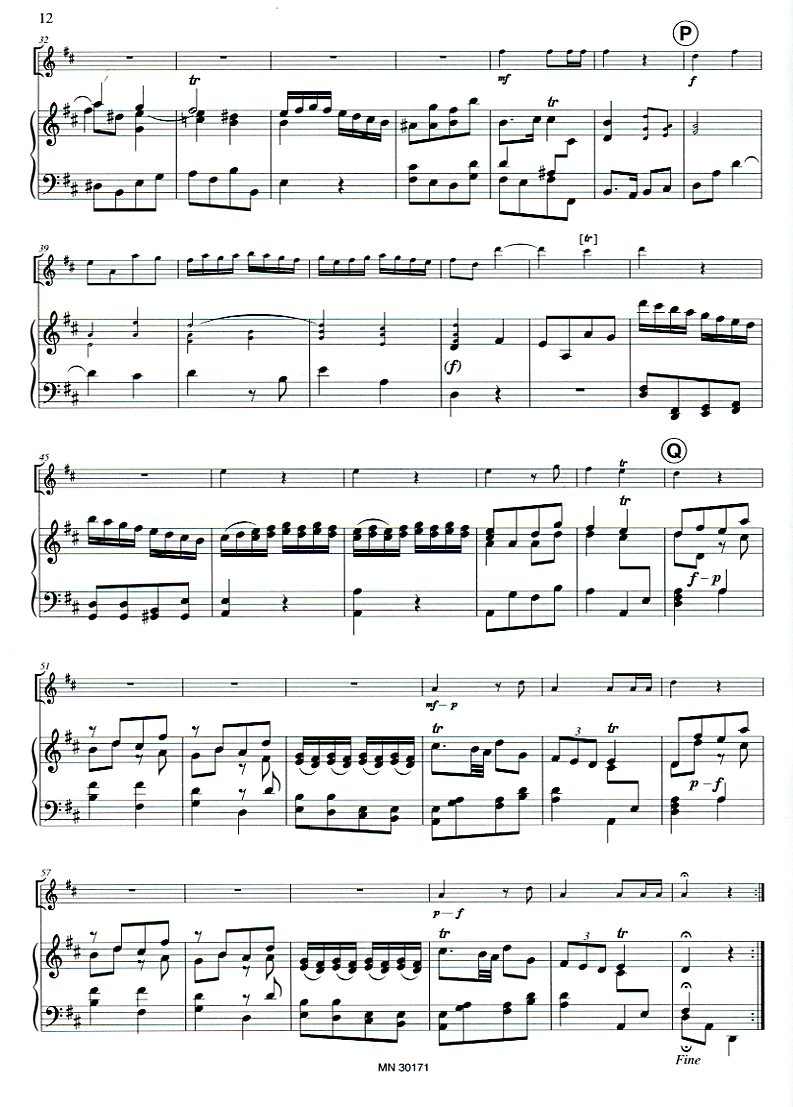
Molter Concerto No. 2 in D major
Instrumentation: Trumpet, Strings, B.c., 2 Oboes and Bassoon ad lib.Range: d' - e'''
Difficulty (I-VI): VI
Parts for: Trumpet in D and high A
Series: Edward Tarr Brass
Editor: Edward H. Tarr
Johann Melchior Molter was born on 10 Febnuary 1696 in Tiefenort (near Eisenach) and died in Karlsruhe on 12 January 1765. It was probably his father Valentin, a teacher and cantor, who first introduced him to the rudiments of music. Later he attended the same Gymnasium in Eisenach where J. S. Bach had been a pupil, and was a member of the Chorus Symphoniacles. In 1715 he left Eisenach. Around 1717 we find him again, this time as a violinist in the service of Margrave Carl Wilhelm of Baden-Durlach, who had transferred his residence two years earlier to the newly-founded city of Karlsruhe, built on a radial plan.
Molter was associated with this residence, with interruptions, up to the end of his life. Two of the interruptions were study trips to Italy. The Margrave sent the young musician with full pay on the first one of these, to Venice and Rome, in 1719-21. On his return Molter was named court Kapellmeister (music director). His second Italian journey in 1737-38 led him, besides the places mentioned, to Bologna and probably also to Naples and Milan, where he studied the latest compositional style. Thus Molter belongs to those Italianate German composers who first knew their Vivaldi and later their Pergolesi and Sammartini.
As court music director, Molter led the court orchestra and composed music for dining, for dances, for other festisities, and last but not least for the German theater. The compositions of his first Karlsruhe period (1722-33) include oratorios and cantatas (nearly all of them now lost) as well as orchestral and chamber music works. The latter survive in large number today, thanks to a bequest made by one of the composer's sons, Friedrich Valentin Molter. This fruitful period came to an abrupt end in 1733 with the outbreak of the War of Polish Succession. The area around Karlsruhe became unsafe, and the Margrave was forced to dissolve his court, including the orchestra, fleeing to nearby Basel. A year later, however, Molter received a position as Kapellmeister in the area of his birth, at the court of Duke Wilhelm Heinrich of Eisenach, in Saxony. During his Eisenach period, he composed many sacred and secular vocal works. When the Eisenach court was absorbed into that of Weimar on the Duke's death in 1741, the orchestra was disbanded and once again Molter was unemployed.
In 1742 he returned to Karlsruhe, but under more modest circumstances than nine years earlier. Besides his other duties, he now had to teach music at the local Gymnasium; and the court orchestra was smaller than before. However, he made a virtue of necessity and composed much chamber music. In 1747 the situation changed for the better when Margrave Carl Friedrich (1728-1811), the grandson of Carl Wilhelm (who had died in 1738), came of age and took over the affairs of state. Molter was given a decent salary and the task of reorganizing the court musical establishment. Up to his death, Molter composed many cantatas, symphonies, concertos, and chamber music, and the orchestra also performed works by other composers. The arts and sciences flounshed under the young Margrave, who later is known to have had contact with Gluck, Goethe, and Klopstock.
Molter's Instrumental Works
Johann Melchior Molter wrote nearly 50 conoertos for one or more solo instruments, as follows flute (10), violin (6), clarinet (6), two trumpets (6), oboe (5), trumpet (3), bassoon (3), and one each for hom, flute d'amore, violoncello, and harpsichord. In addition to these, certain other works may be mentioned, such as the "Sonata grossa" in D major for 2 clarini and principale, timpani, 2 oboes, bassoon, 2 violins, violetta, and basso continuo, a Sinfonia in F major for 2 trumpets, 5(!) timpani, 2 transverse flutes, cornetto, 2 violins, violetta, and harpsichord, and two quite interesting Sinfonias in D major for winds (trumpet, 2 oboes, 2 horns, and bassoon). Molter's clarinet concertos, which he wrote for the Karlsruhe virtuoso Johannes Reusch (who also played the flute and the oboe), are considered to be the very first ones for that instrument. Optically, they can hardly be distinguished from the trumpet concertos, since both instruments are confined to the harmonic series notes based on D. Nevertheless, the clarinet concertos contain certain significant deviations from this restriction, in that here and there a rare low note outside the series can be found; furthemmore, the clarinet ascends higher than the trumpet, to written g"' (sounding a"').
Molter's Trumpet Concertos
Molter's three exacting trumpet concertos seem to have been composed in rapid succession around or shortly after 1750 for the court trumpeter Carl Pfeiffer, who is mentioned in a dossier as a "Concert[istl" and together with 3 and 4 other trumpeters, respectively, in a list of payments from 1738 (all with the same pay) and in a calendar from 1763. (This information was kindly provided by the library director Klaus Häfner, Karlsruhe, in a letter to Reine Dahlqvist from 23 September 1978, and communicated in Dahlqvist's 1988 dissertation on p. 232.) Their florid style lies between the Baroque and Classical periods.
As opposed to most Baroque trumpet concertos, in which the soloist's participation is limited to dle outer movements, Molter's slow movements contain wonderful moments for the soloist. Certainly, in these movements, in which the trumpet is treated in its high register like a flute, the soloist's endurance is challenged to the full; for example, the slow movement of Concerto No. 3 only contains two single quarter-note rests. On the odter hand, the final movements of these works are slight, entertaining sketches in which the solo instrument is no longer in the foreground.
As far as the degree of difficulty of these works is concerned, they stand on about the same level as the concertos, now well-known, by lohann Friedrich Fasch (1688-1758), Georg Philipp Telemann (1681-1767), Leopold Mozart (1719-87), Johann Wilhelm Hertel (1727-89), and Johannes Sperger (1750-1812), the trumpet parts of which all have a range from c' or g' to c"' or d"' (transposed notaton; sounding higher, depending on the key in question), whereby Molter's concertos certainly do not belong to the easier ones, because of their extended high tessitura.^



